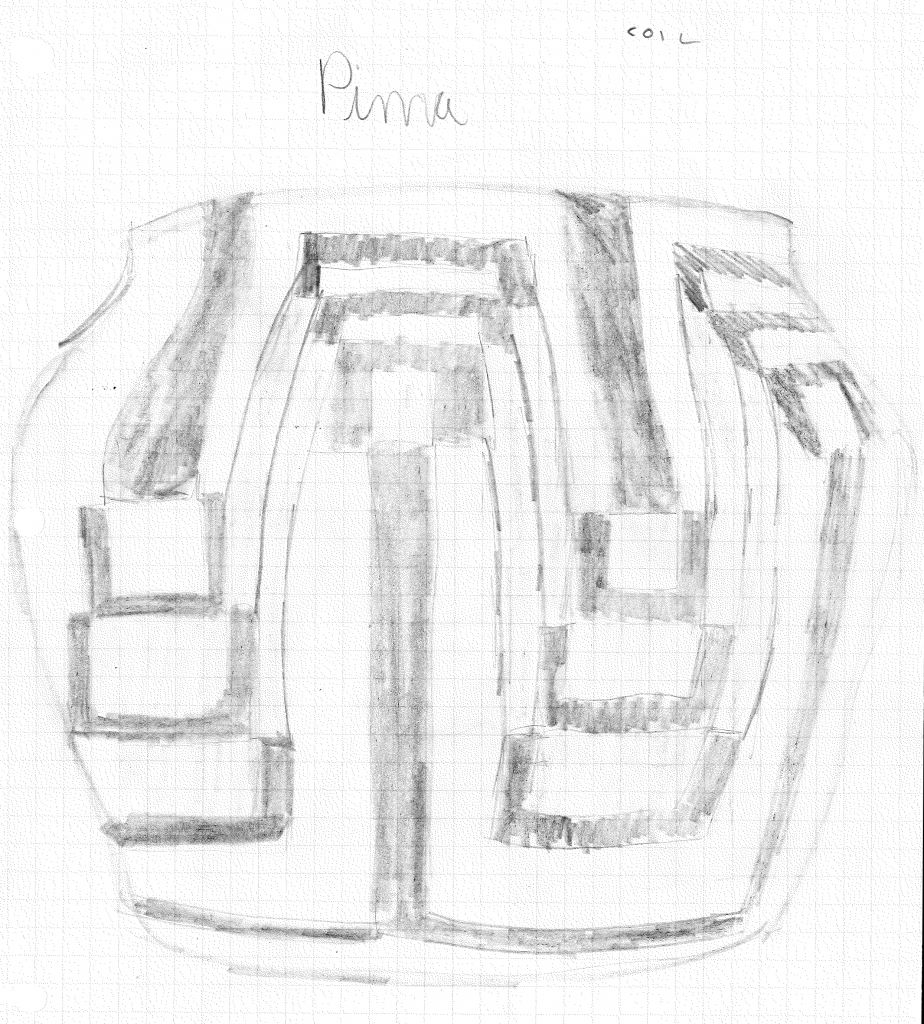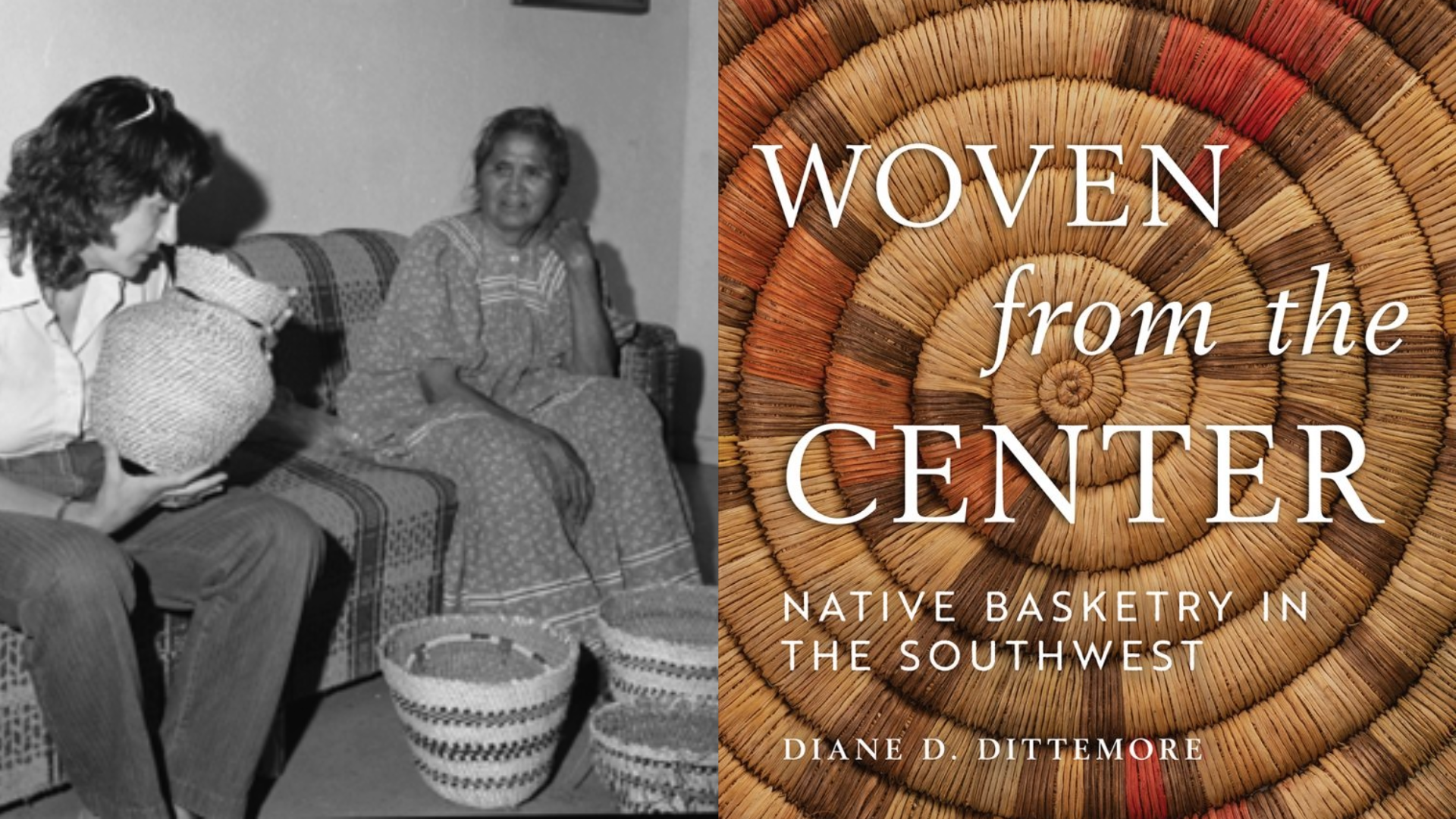January 9, 2024
In Woven from the Center: Native Basketry in the Southwest, author Diane Dittemore presents breathtaking basketry from some of the greatest weavers in the Southwest. Today, Dittemore has provided us with field notes and insights into her work.
My first encounter with Southwestern basketry was a Tohono O’odham basket I grew up with, one my grandmother Minnie Harper kept on her dresser and used to hold letters. I never thought to ask her where she got it, but it likely dates to the 1920s when she was living in Trinidad, Colorado.

I began serious study of Native art in graduate school for anthropology and museum studies at the University of Denver beginning in 1975. The Native American Arts and Industries class instructor was Richard Conn, renowned Curator of Indian Art at the Denver Art Museum. The Native Arts floor at DAM was our classroom, my first “fieldwork” site, albeit in a domesticated space largely absent images of the people responsible for the works displayed. For the class, we were tasked with drawing selected pottery, basketry, weavings, and beadwork on display. This was an excellent means of studying Native cultural arts, although my artistic skills were and still are wanting! In a foreshadowing of my eventual professional life’s work, I rendered a Pima (Akimel O’odham) jar.

In 1977, I conducted my first actual fieldwork in Mexico for a master’s thesis researching one-stringed fiddles made by Comcaac (Seri) of Sonora’s west coast. My thesis topic ended up a comparison of Seri and Western Apache fiddles. While concentrating on musical traditions and conducting fieldwork in the Comcaac village of Desemboque, I also purchased several baskets and learned from weavers about materials, technology, and cultural contexts.
My field partner, Seth Schindler, who was researching for his PhD dissertation on Comcaac material culture, later became my husband. Nothing like having a first date consist of weeks on end camped on the beach, sharing a tent much to the disapproval of a few Comcaac women.
I began work as curator of the ethnology collections at the Arizona State Museum in 1979. Included in these collections are over 4000 examples of basketry from all over the world but primarily from the American Southwest and Northwest Mexico. This collection offers limitless opportunities for museum-based research.


In the 1980s and early 1990s I set out with museum photographer Helga Teiwes to document O’odham and Western Apache basket weavers. We took trips to the Apache reservations of San Carlos and Ft. Apache, and to the Pima (Akimel O’odham) Gila River Indian Community.



My first publication, in American Indian Art Magazine, focused upon unique Akimel O’odham (Pima) baskets decorated with glass beads. By this time, the weavers at Gila River (of which there were very few) were no longer incorporating beads, so fieldwork was a very limited component of this research.

The 1990 fieldwork at the San Carlos Apache Reservation was conducted in part to talk to weavers and other culture bearers about certain eccentric marks on early 20th century coiled basketry, to determine whether they might have special significance. This resulted in a 1998 publication with Museum Conservator Nancy Odegaard, Eccentric Marks on Western Apache Coiled Basketry.
I co-authored another American Indian Art Magazine article, Anonymous Was a Weaver: In Search of Turn-of-the-Century Western Apache/Yavapai Basketry Artists (Summer 1999). At this time there were no Apache or Yavapai weavers still making the gargantuan ollas that were the subject of this article, so the fieldwork involved visiting sister institutions.


In 2010, with ASM’s basketry collection given the designation as an American Treasure through the federal Save America’s Treasures program, planning commenced for a permanent ASM basket exhibit that came to be called Woven through Time: American Treasures of Southwest Native Basketry and Fiber Art. I served as the lead curator for this exhibit, which opened in 2017. We commenced a major initiative to acquire examples of work by contemporary basket weavers, in order to show visitors to Woven through Time that the millennia-old tradition continues to the present. With museum photographer Jannelle Weakly, we traveled to weavers’ homes, and to galleries and art fairs to purchase baskets and photograph the makers.

ASM secured the services of AZPM to create a video for the Woven through Time gallery about the continued importance of basketry among Arizona’s Native communities. We recorded weavers from the Salt River Pima-Maricopa Indian Community as they gathered willow and cattail basketry materials. Of course, the time to collect these materials is in July! So, on a day in 2016 when the high was expected to be 114 degrees, we met the weavers and video graphed their efforts.

I began serious work on the basket book, Woven from the Center during a 2013 sabbatical, envisioning it as a companion to the exhibit Woven through Time: American Treasures of Native Basketry and Fiber Arts. After numerous delays, involving weathering the scourge of Covid with attendant museum closures and other challenges, I submitted the manuscript in 2022.
A major goal of Woven from the Center: Native Basketry in the Southwest, in addition to sharing the Arizona State Museum’s unparalleled collection of Southwest Native basketry, is to bring the weavers—past and present—out of anonymity and give them full acknowledgment as keepers of traditions that continue to have deep resonance within their respective tribal communities.
***
Diane Dittemore is the Associate Curator of Ethnological Collections at the Arizona State Museum, an anthropology museum at the University of Arizona. For forty-five years, she has curated, interpreted, and written about ASM’s peerless collection that is focused on historic and contemporary works made by Indigenous people of the American Southwest and Mexico.
 The University of Arizona Press
The University of Arizona Press


